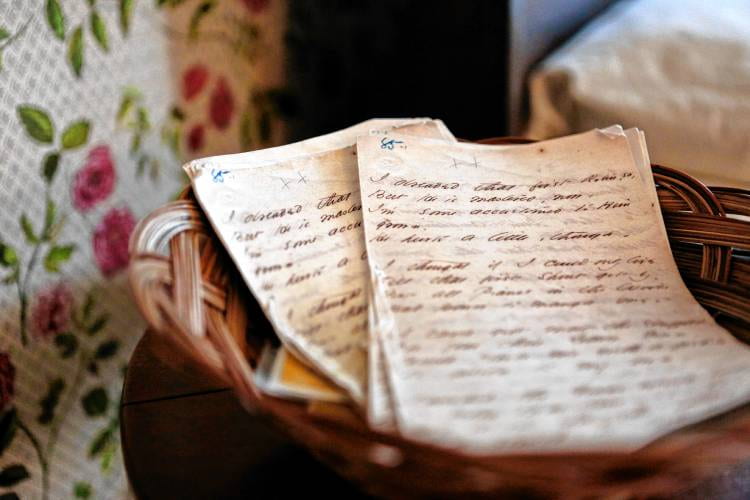
Book-Making: Fascicle 12
Emily Dickinson was ambivalent about the publishing industry of her time, to say the least. She was aware of the gendered conventions and limitations placed on women writers and thought her poetry would not be conveyed accurately in print. The editorializing of her work both during and after her lifetime shows she was right. A Dickinson poem is hard to capture in a single traditionally printed manuscript or the sea of print and columns that was a mid-nineteenth-century newspaper page. Many of her friends urged her to publish her work, and editors approached her. The eleven poems published during her lifetime appeared without her permission or supervision and often caused her consternation.
Instead, Dickinson chose a form of self-publication that allowed her to edit and organize her poems into groups on her own terms. From 1858 to around 1864, Dickinson made fair copies of her poems on fine paper, placed the folded sheets on top of each other and hand sewed the manuscript pages together, creating little booklets her first editor, Mabel Loomis Todd, called "fascicles," which contained hundreds of her poems. In the early 1860s, she began including variants of words and phrases on the fair copies, often indicated by a small cross in the text next to the word with the variants in a list at the bottom of the page or on the sides or sometimes over the word itself. The variants thus become a part of the poem, which itself becomes dynamic and performative. The transcriptions we provide in the Poems section reproduce Dickinson's variants.
Dickinson produced forty fascicles (that we know of). She never labeled or dated them or the poems in them, or gave them numbers or titles. When they were discovered after her death, her editors immediately took them apart; now, multiple reconstructions of the fascicles exist, not all agreeing. In 1981, Ralph Franklin undertook a painstaking re-assemblage (based in part on the direction the needle went into the paper!) and printed the fascicles in manuscript, which is the closest way of reading Dickinson as she organized and presented herself. In an important study from 1992, Sharon Cameron argues that reading Dickinson's poems in the fascicle groupings substantially changes our understanding of her work. The inscrutable, difficult single lyric poem stands in a rich and complex, perhaps, more comprehensible context. In 2016, Cristanne Miller published a reading edition based on the fascicles titled Emily Dickinson’s Poems: As She Preserved Them. In addition to disagreement over how the sheets go together, there is also lively debate over why the sheets go together – what did Dickinson intend by grouping these specific poems and in that specific order? How does the context of a fascicle inform the reading of her poetry? Why do some poems appear in multiple fascicles? How do the fascicles relate to each other? Some scholars, like Franklin, view the fascicles merely as a way for Dickinson to organize her poems, part of “her workshop” in a period of immense productivity. Others see them as poetic sequences with a consistent narrative or organizations of complex relationships. Cameron goes further, arguing that they represent, as the title of her study pithily puts it, Dickinson's approach of Choosing Not Choosing. That is, the fascicles illustrate Dickinson’s self-conscious playfulness and her resistance to closure or fixity. Given this important, though understudied way of reading Dickinson's poems, we thought it important to explore one of the first fascicles Dickinson put together in early 1862, Fascicle 12.
In addition to disagreement over how the sheets go together, there is also lively debate over why the sheets go together – what did Dickinson intend by grouping these specific poems and in that specific order? How does the context of a fascicle inform the reading of her poetry? Why do some poems appear in multiple fascicles? How do the fascicles relate to each other? Some scholars, like Franklin, view the fascicles merely as a way for Dickinson to organize her poems, part of “her workshop” in a period of immense productivity. Others see them as poetic sequences with a consistent narrative or organizations of complex relationships. Cameron goes further, arguing that they represent, as the title of her study pithily puts it, Dickinson's approach of Choosing Not Choosing. That is, the fascicles illustrate Dickinson’s self-conscious playfulness and her resistance to closure or fixity. Given this important, though understudied way of reading Dickinson's poems, we thought it important to explore one of the first fascicles Dickinson put together in early 1862, Fascicle 12.
“Life in Washington. Through the Spectacles of a Lady”
INTERNATIONAL
Short news articles appeared this week on the history of French emancipation (presumably to apply to Civil War tactics and the lively emancipation debate in the North), and on the “Rejuvenation of Spain,” referring to the country’s reinvigorated military and economic power at the outset of the Second French Intervention in Mexico, when Spain joined with France and Britain to forcibly collect debts from Mexico after the country declared a suspension of loan payments to foreign creditors.
NATIONAL
Victory, with a teeming sense of urgency and anxiety, color this week’s affairs. The Springfield Republican’s “Review of the Week” describes how a “great victory crowns the new campaign,” referring to a battle in Kentucky where the Union obliterated a Confederate camp, seized some supplies, and pushed the enemy into retreat. The Hampshire Gazette contains the full report from Washington, and both papers pulled some quotations from Southern newspapers to show the past few weeks’ effect on Confederate morale. Numerous strong Union victories put a damper on things, and the Republican concludes that the only hope the “rebels” have is not to lose the whole war very badly. The “educated Southern men” are said to “rebel against the rebels,” and to think that the constant fighting is now pointless.
Also in the Springfield Republican, lengthy war preparation reports from states in New England follow some important upheavals in the North. On January 27, President Lincoln ordered all land and naval troops to advance southward by February 22 (George Washington’s birthday) to avoid Major General McClellan’s vastly unpopular waiting game war tactics. Lincoln also appointed Edwin Stanton as new Secretary of War, replacing Simon Cameron after allegations of corruption surfaced. The Hampshire Gazette chronicles an interview with Lincoln about this cabinet change, to which he replied his cabinet now feels more “cohesive.”
Two op-eds stand out in this week of taxation complaints: one about the unchanging and ever-similar “American Society” of both the North and the South, and one entitled “Life in Washington. Through the Spectacles of a Lady.” An anonymous upper class woman tells of her trip to the Senate to hear Charles Sumner’s speech on the Trent Affair,

including the sights of Washington, the distinguished socialites present (including other famous women), the politics discussed and derived from the experience, and the conclusions of the speech. The author makes a point to talk to the reader directly, her tone of voice and astute observations about Washington revealing that a woman, too, can not only engage in public political life but also form her own opinions on the happenings in Washington.
“A State of Constant Flux”
No letters are definitively linked to this week, but then we don’t know exactly when Dickinson wrote most of her letters. Over the next two weeks, Dickinson will pen multiple letters to Samuel Bowles, who is preparing to travel to Europe for his health. Some of these letters included poems, both old and brand new.

Another task that occupied part of Dickinson’s time was the production of her fascicles, and we focus this week on Fascicle 12. Cristanne Miller dates its sheets from early 1861 all the way to April 1862, and probably later than that. As is clear from the widely varied dates of different sheets, Dickinson was in a state of constant flux and revision with her fascicles, and frequently edited them by taking poems out or putting poems in, editing words and adding alternate choices, and probably re-sewing them together as well.
Reflection
Madeline Killen
 Believe it or not, I made it to age 18 and through an entire American public school education without reading an Emily Dickinson poem. The “Emily Dickinson” card in my mental rolodex had a couple of bullet points — recluse, apparently couldn’t stop for death — but was otherwise blank. Whether related to my Dickinson ignorance or not, I’d also never developed a particular affinity for poetry, choosing the less fair house of prose any day. I disliked that poetry so often felt like a locked chest with one little gem hidden inside; I wasn’t interested in searching for the key to a form that was so eager to resist me.
Believe it or not, I made it to age 18 and through an entire American public school education without reading an Emily Dickinson poem. The “Emily Dickinson” card in my mental rolodex had a couple of bullet points — recluse, apparently couldn’t stop for death — but was otherwise blank. Whether related to my Dickinson ignorance or not, I’d also never developed a particular affinity for poetry, choosing the less fair house of prose any day. I disliked that poetry so often felt like a locked chest with one little gem hidden inside; I wasn’t interested in searching for the key to a form that was so eager to resist me.
Yet somehow, as my undergraduate career comes to a close, I find myself writing a senior honors thesis on one of the most interpretation-resistant poets imaginable. In an ironic turn of events, it’s Dickinson’s seeming inaccessibility that makes me love her poetry as much as I do. She’s not inaccessible, she’s impossible; trying to decipher the core meaning of any one of her poems is a completely futile exercise, simply because there isn’t one. Rather than being infuriating, that’s liberating — Dickinson poems change depending on the angle you look at them from, like the smooth side of a seashell in the sunlight. Nowhere is this more striking than in her fascicles, where Dickinson’s choices of order and proximity cause you to lose your grasp on what you believe she’s writing about the moment that you start to feel confident about it.

When Fascicle 12 starts with “I taste a liquor never brewed -,” I see a Dickinson in love; can any phrase describe a lover struck by the “extasy” of their reciprocated feelings like “Inebriate of air –”? This leads me to a single reading of the brutal drop in mood from the fascicle’s first poem to the later “I got so I could hear his name -” — a broken heart trying to mend.
I got so I could stir the Box -
In which his letters grew
Without that forcing, in my breath -
As Staples – driven through -
Can any Dickinson reader envision anything now besides Dickinson shifting through her correspondence with Master? But this is the brilliance of Dickinson’s fascicles — “A single Screw of Flesh” depicts a tortured relationship with a “Deity” and casts the preceding poem in a different light. Could the Box in which his letters grew be a Bible? Are we watching Dickinson fall from faith or fall out of love? Both, and neither, and who knows, and what does it matter? We dwell in possibility now.
Bio: Madeline is a member of the Dartmouth class of 2018, where she completed an English honors thesis, supervised by Ivy Schweitzer, that focuses on Dickinson's Fascicle 18. An English major and an Italian minor, she took “The New Dickinson: After the Digital Turn” seminar, which inspired her thesis topic, in Winter 2017. A chapter of that thesis on the variants of "Bliss" won the award for best undergraduate essay on Dickinson from the Emily Dickinson International Society in 2018.
Sources
Overview and Biography
Cameron, Sharon. Choosing Not Choosing: Dickinson’s Fascicles. Chicago: University of Chicago Press, 1992.
Dickinson, Emily. Emily Dickinson’s Poems: As She Preserved Them. Ed. Cristanne Miller. Cambridge: Belknap Press of Harvard University Press, 2016.
Dickinson, Emily. The Manuscript Books of Emily Dickinson. 2 vols. Ed. Ralph Franklin. Cambridge: Belknap Press of Harvard University Press, 1981.
Heginbotham, Eleanor Elson. “Fascicles.” An Emily Dickinson Encyclopedia. Ed. Jane Donahue Eberwein. Westport, CT.: Greenwood Press, 1998: 108-09.
History
Hampshire Gazette, Volume 76, Issue 26. January 28, 1862.
“January 27: This Day In History.” History.com
Springfield Republican, Volume 80, Issue 4. January 25, 1862.



